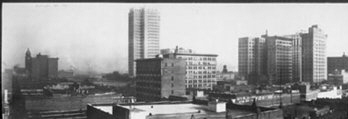|
Birmingham was founded on June 1, 1871 by real estate promoters who sold lots near the planned cro ssing of the Alabama & Chattanoo ga and South & North railroads. The site of the railroad crossing was notable for the nearby deposits of iron ore, coal, and limestone - the three principal raw materials used in making steel. Birmingham is one of the very few places worldwide where significant amounts of all three minerals can be found in close proximity. From the start the new city was planned as a great center of industry. The founders borrowed the name of Birmingham, England's principal industrial city, to advertise that point. Birmingham got off to a slow start: the city was impeded by an outbreak of cholera and a Wall Street crash in 1873. But soon afterward the city began growing rapidly. ssing of the Alabama & Chattanoo ga and South & North railroads. The site of the railroad crossing was notable for the nearby deposits of iron ore, coal, and limestone - the three principal raw materials used in making steel. Birmingham is one of the very few places worldwide where significant amounts of all three minerals can be found in close proximity. From the start the new city was planned as a great center of industry. The founders borrowed the name of Birmingham, England's principal industrial city, to advertise that point. Birmingham got off to a slow start: the city was impeded by an outbreak of cholera and a Wall Street crash in 1873. But soon afterward the city began growing rapidly.
The turn of the century brought the stupendous growth that gave Birmingham the nickname "The Magic City" as the downtown area rapidly developed from a low-rise commercial and residential district into a busy grid of neoclassical skyscrapers and busy streetcar lines. Between 1902 and 1912 four large office towers were constructed at the intersection of 20th Street, the central north-south spine of the city, and 1st Avenue North, which connected the warehouses and industrial facilities stretching along the east-west railroad corridor. This impressive group of early skyscrapers were nicknamed "The Heaviest Corner on Earth".
The Great Depression hit Birmingham especially hard as sources of capital that were fueling the city's growth rapidly dried up at the same time that farm laborers, driven off the land, made their way to the city in search of work. New Deal programs made important contributions to the city's infrastructure and artistic legacy, including such key improvements as Vulcan's tower and Oak Mountain State Park.
The wartime demand for steel and the post-war building boom gave Birmingham a rapid return to prosperity. Manufacturing diversified beyond the production of raw materials and several major cultural institutions, such as the Birmingham Museum of Art were able to expand their scope.
In the 1950s and '60s Birmingham received national and international attention as a center of the civil rights struggle for African-Americans. The city was given the derivsive nickname Bombingham because of a string of racially motivated bombings that took place during this time. A watershed in the civil rights movement occurred in 1963 when Martin Luther King, Jr., imprisoned for having taken part in a nonviolent protest, wrote the now famous Letter from Birmingham Jail, a defining treatise in his cause against segregation. Birmingham is also known for a bombing which occurred later that year. Four black girls were killed by a bomb planted at the 16th Street Baptist Church.
In the 1970s urban renewal efforts focused around the development of the University of Alabama at Birmingham, which developed into a major medical and research center. In 1971 Birmingham celebrated its centennial with a round of public works improvements, including the upgrading of Vulcan Park. Birmingham's banking institutions enjoyed considerable growth as well and new skyscrapers started to appear in the city center for the first time since the 1920s. These projects helped the city's economy to diversify, but did not prevent the exodus of many of the city's residents to independent suburbs. In 1979 Birmingham elected Dr. Richard Arrington Jr. as its first African-American mayor.
Following the same pattern as many other American cities, the population inside Birmingham's city limits has fallen over the past few decades. From 340,887 in 1960, the population was down to 242,820 in 2000, a loss of about 29 percent. However, the growth of Birmingham's suburbs over that same period has kept the metropolitan population growing. Over the course of the 20th century, while industry declined nationwide, banking, law, medicine, research and publishing emerged as Birmingham's new economic engines.
Today, Birmingham has begun to experience a bit of a rebirth. Currently there are hundreds of millions of dollars being invested in reconstructing the downtown area into a 24-hour mixed-use district. The market for downtown lofts and condominiums has mushroomed while restaurant, retail and cultural options are beginning to sprout up. |
